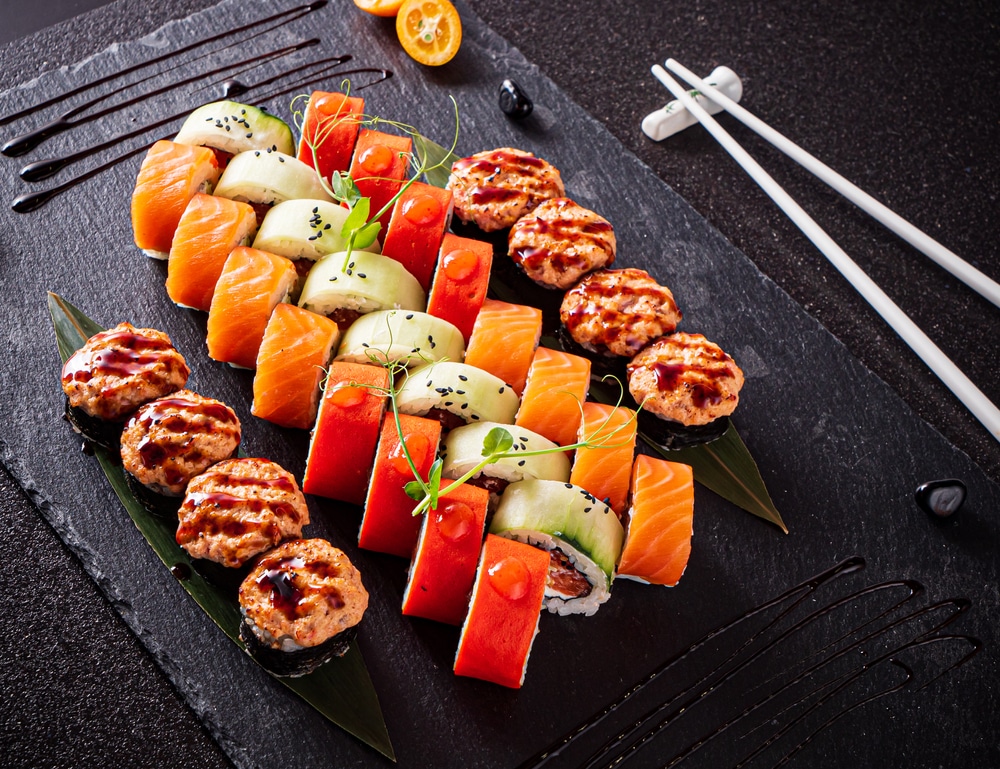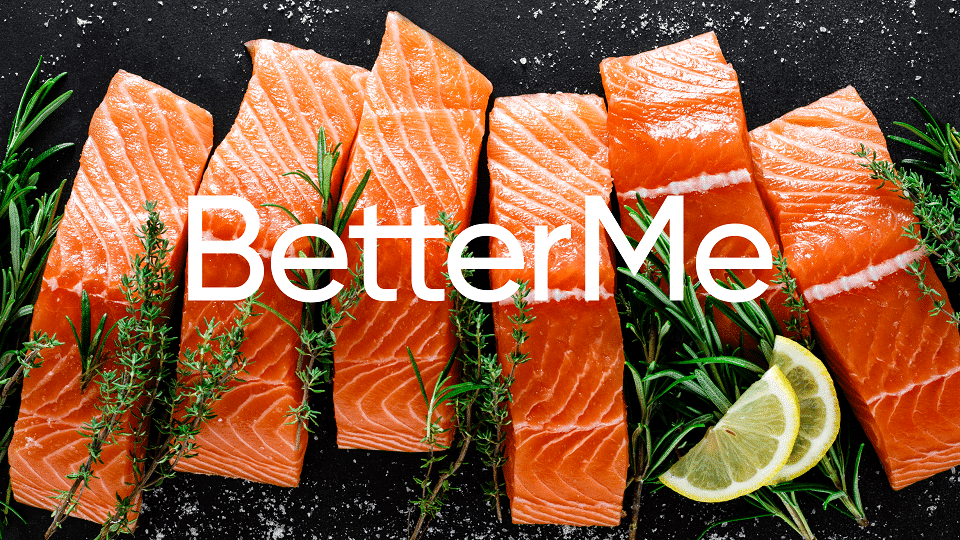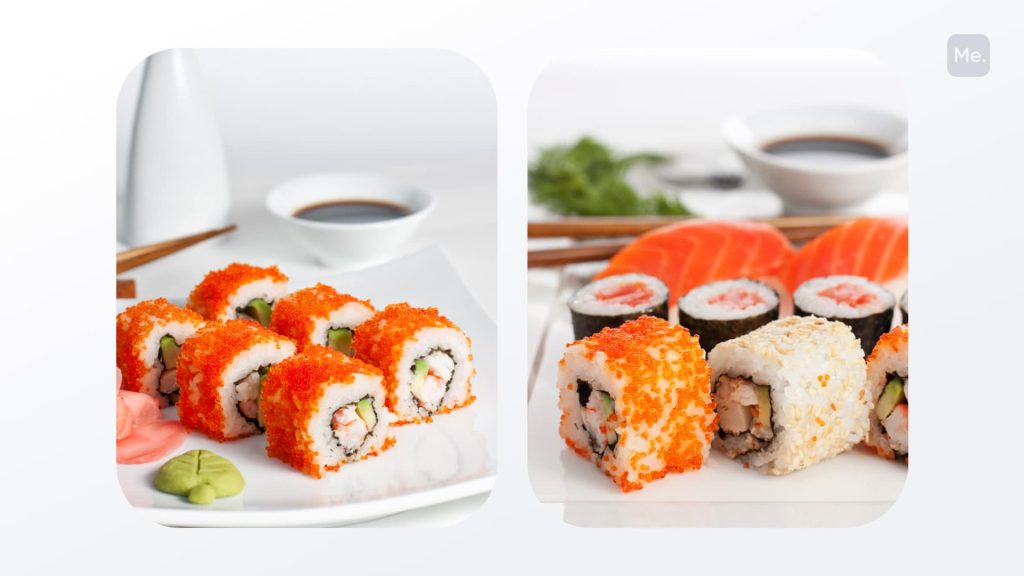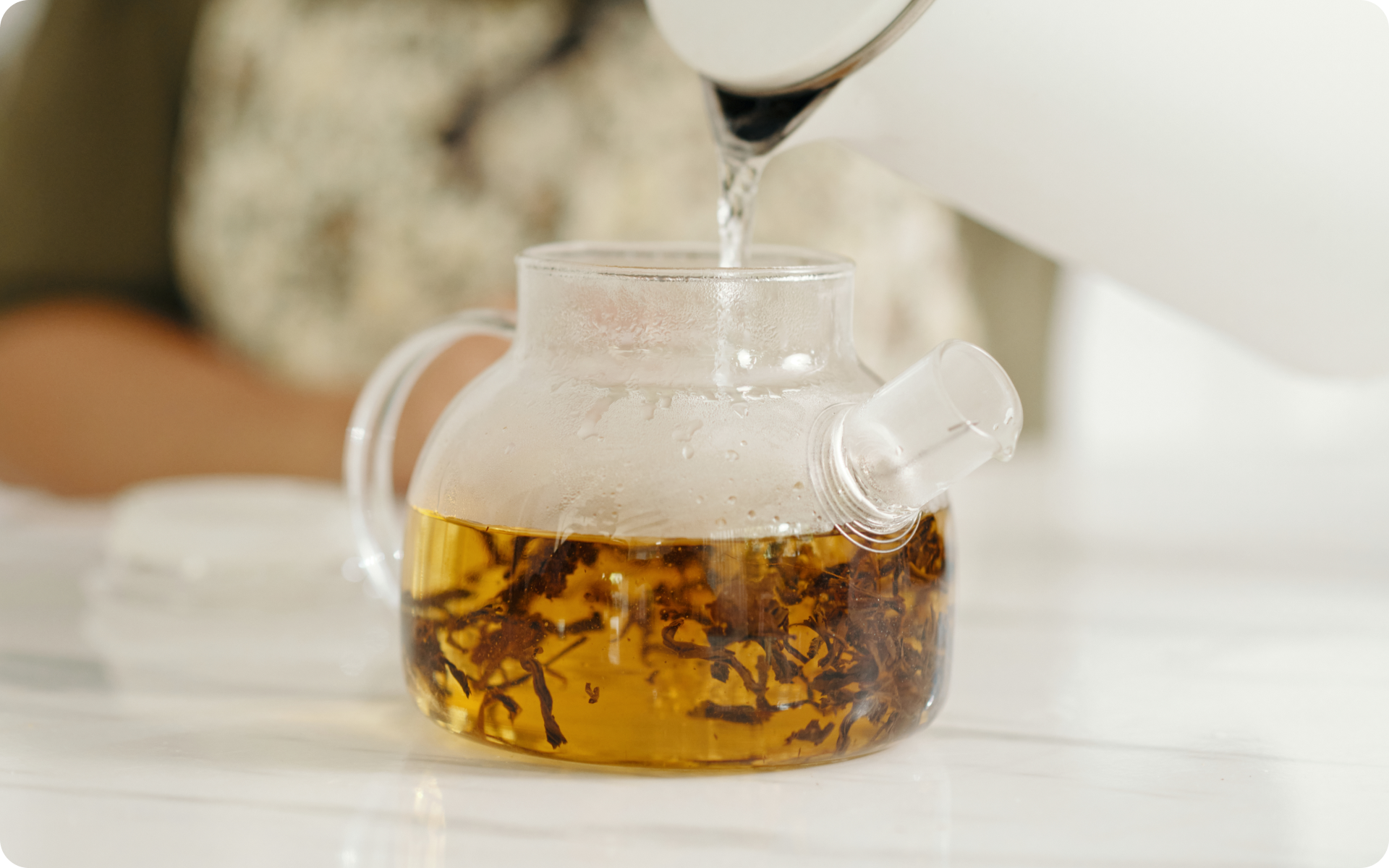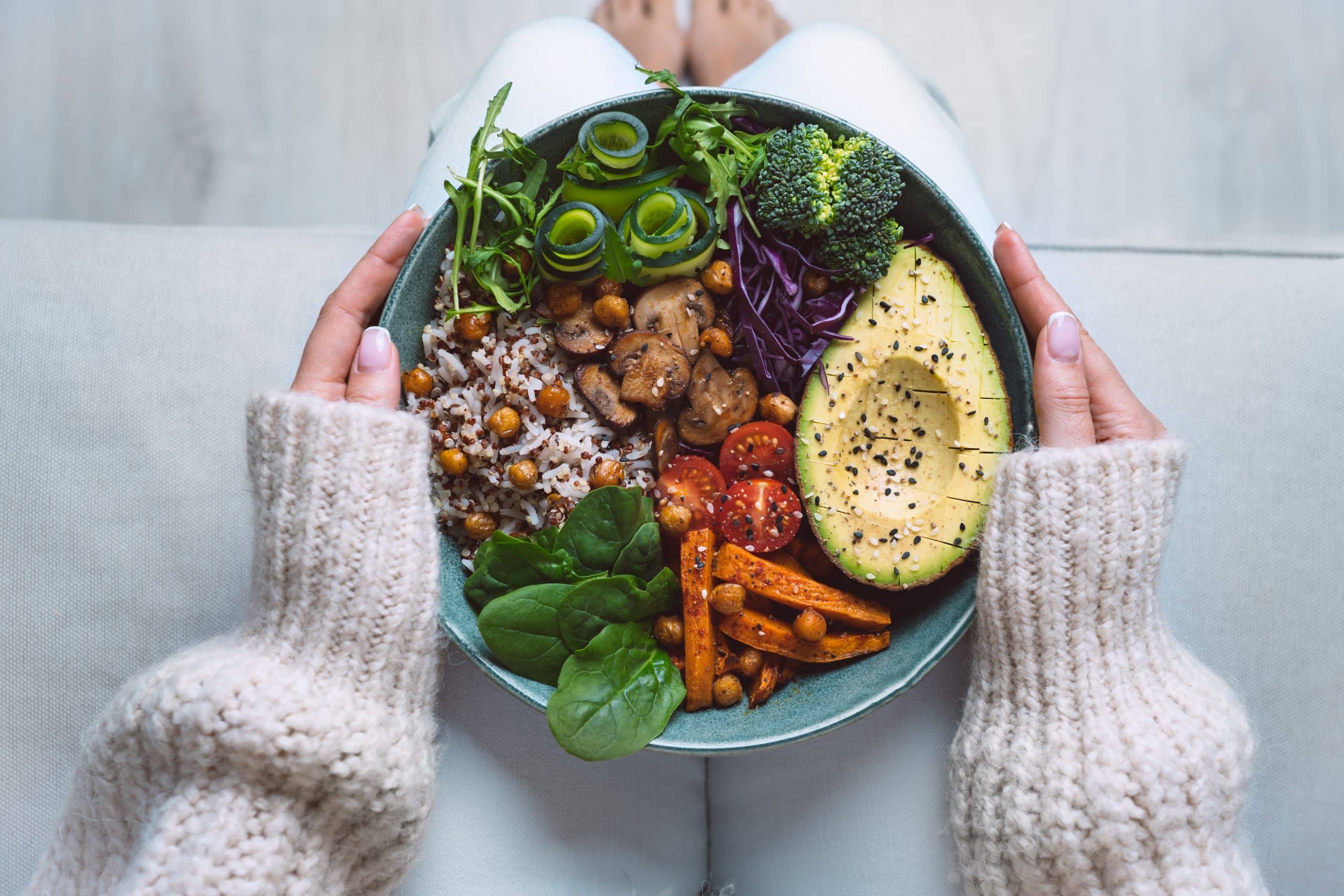No one can dispute the connection between nutrition and weight loss, keeping in mind that you are what you eat, as the common saying goes. If you do not develop a proper diet plan, you may not lose weight as you desire. Even the amount of exercise you do daily might not be enough on its own because you may be adding more calories than you burn. There are many types of trendy nutrient-dense foods, such as cinnamon, hemp seeds, and curry leaves, and they are said to help bust belly fat. Eating raw seafood such as sushi has been said to have many benefits, but some people are skeptical of this. Is sushi healthy for weight loss?
Get your personalized
meal plan!
First, sushi does not refer to just one particular food but a wide variety of different menu options. Having known this then the next thing to do is identify the types of sushi that are healthy and the ones that are not. As much as some types may not be good for you, most basic options, such as Salmon nigiri sushi, are believed to connect with weight loss. While many people eat sushi just as an adventure to experience, those who know its benefits have made it a regular part of their diets.
What Is Sushi?
What is sushi? It is a seaweed roll filled with cooked rice, fish (raw or cooked), and various vegetables. Typically, it is served with soy sauce, pickled ginger, and wasabi.
The basic types of sushi are nigiri and sashimi. Nigiri is a raw fish that is placed over a small portion of rice. Sashimi, on the other hand, is raw fish or meat thinly sliced with minimal ingredients (5).
Is Sushi Healthy For Weight Loss?
Is sushi good for weight loss? In itself, sushi might not be the best weight-loss tool, but as long as you are careful when it comes to the sauces you are adding and limiting fried tempura options, it can be a component of a healthy weight-loss diet.
Sushi happens to be great for a balanced diet due to its good balance of protein, carbohydrates, and fats. The challenge here is that you can easily overeat carbs since each bite has large amounts of sushi rice. Some sushi types may contain more fat than others, while others have no fat at all.
It can be healthy because it is prepared with nutrient-dense foods such as seaweed, avocados, and fresh vegetables. The fish in it provides protein, iodine, and a good amount of vitamins and minerals. All that aside, fish also happens to be one of the few foods that naturally have vitamin D.
We can’t forget that the fish has Omega-3 fatty acids, which help the body and brain function optimally. Apart from losing weight, you also want to live a healthy lifestyle. Eating oily fish may help lower the risk of autoimmune diseases, loss of memory and vision in old age, and depression (9).
Another ingredient that makes sushi healthy is wasabi. The wasabi paste is usually served alongside sushi. It has a powerful flavor, and for that reason, it is eaten in small quantities. Wasabi belongs to the same family as mustard, cabbage, and horseradish. It is rich in glucosinolates, carotene, and isothiocyanates. These compounds are associated with antibacterial, anti-inflammatory, and anticancer properties.
To answer the question, sushi can be healthy for weight loss depending on the roll components.
Is Sushi Rice Healthy For Weight Loss?
Most sushi menus contain white rice, which can also be a side dish. White rice and other refined carbohydrates such as white pasta white bread and sugary foods can impede losing weight. They are types of carbs that cause blood sugar and insulin spikes and increase cravings for carbohydrates, making it difficult to manage your weight (13). White rice has been stripped of the fiber that brown rice contains, and does not make one feel as full after eating it, which can also have impacts on a weight loss journey.
Whether you’re looking to simply pep up your fitness routine, jazz up your diet with mouth-watering low-calorie recipes or want to get your act together and significantly drop that number on your scale – BetterMe app has got you covered! Improve your body and revamp your life with us!
Cooked Fish Vs. Fresh Fish: Which One Is Better For Weight Loss?
There’s no doubt that fish is good for you. It’s a lean protein that’s low in calories and saturated fat, and it’s packed with omega-3 fatty acids, which are good for your heart. But when it comes to weight loss, you may be better off eating fresh fish rather than cooked fish.
One reason is that cooking fish can make it more calorie-dense. When you cook fish, you’re typically adding calories in the form of fat or breading. This can make it harder to lose weight, even if the fish itself is low in calories.
Another reason is that fresh fish is often processed less than cooked fish. Processing can remove some of the nutrients in fish, including omega-3 fatty acids. This means that fresh fish may be more beneficial for your health overall, which can also help with weight loss.
If you’re trying to lose weight, you may want to focus on eating fresh fish instead of cooked fish. This doesn’t mean you have to eat fish raw; sushi is a great option if you’re looking for a way to enjoy fresh fish without cooking it.
That said, eating sushi isn’t a guaranteed weight-loss strategy. If you’re eating sushi rolls that are high in rice and other fillers, you may end up consuming more calories than you would from a cooked fish dish.
Things To Consider Before Buying Sushi
-
Start With The Right Protein
All fish is considered lean protein, and even the fattier fish will provide the essential omega-3 fatty acids. The Omega-3 fatty acids are beneficial for your heart because they may help lower the risk of heart disease. In this case, go for sushi made from salmon, tuna, or trout. However, you may want to be careful with large fish like tuna because it can contain high mercury contamination levels.
-
Vary Your Choices
In most cases, people tend to go for sushi with the same type of fish. Instead, you should vary your choices to optimize your nutrient intake. Different types of fish and vegetables come with different minerals, vitamins, and fatty acids. Having more types of fish and other ingredients in your sushi means you will be getting a variety of nutrients (2).
-
Monitor The Extras
Your sushi nutrition can get a major boost by adding ginger and wasabi. This is because those things contain anti-inflammatory and immunity perks. Avoid ingredients like tempura (including all other fried things) and tobacco because these are your enemies. They are packed with lots of extra calories that you do not need.
-
Watch Your Portion
Since it contains things like rice vinegar and sugar that spike sushi roll calories, this menu item may not be super healthy. If you eat too much sushi often, then those unhealthy ingredients will have their toll on you. You are watching your calorie intake, so you ought to stick to one sushi roll, and it could even be sashimi (made of thinly sliced fish, without the rice) (3).
-
Go For Brown Rice
You may not be willing to give up the rice in your sushi. What should you do? You can mix a little regular sushi rice with brown rice to up the health factor. This is because brown rice contains fiber that will keep you full for long. It also has other nutrients, including zinc, vitamin E, manganese, magnesium, and selenium. White rice adds carbs to sushi without much nutritional value. This can increase sushi calories which in turn cause blood sugar and insulin spikes potentially leading to weight gain. The only advantage of white rice is that as it cools, the amount of resistant starch increases hence lowering the glycemic response. But if you can, choose brown rice for the fiber and other nutrients.
Read More: Brown Rice Diet: Why You Should Double Down On This Underappreciated Grain
-
Reduce Sodium
Sodium will only make you feel bloated. It is recommended that a person should not take more than 2,300 milligrams of sodium per day. By adding two tablespoons of soy sauce to sushi, you will have almost reached the daily sodium requirement. To avoid this, ask for sushi with low sodium soy sauce because its sodium content is 40% less (12). You can also reduce the amount you use or skip it altogether.
-
Avoid Special Sauce
Sushi is typically prepared with eel sauce, a mixture of soy sauce and sugar. Spicy rolls made of mayo mixed with chili paste are also common. The above-mentioned and other creamy rolls will only add calories and fat.
-
Choose Your Sushi Rolls Carefully
We cannot emphasize enough that sushi rolls vary in their ingredients. Some have fried seafood (tempura) or creamy sauces, while others contain raw fish, avocado, and fresh cucumber. Since your mission is to lose weight, choose rolls with lighter whole food ingredients (10).
If you struggle to even flirt with the idea of giving up your favorite foods or working out till your legs give way – BetterMe app is here to breathe a fresh perspective into the way you view the weight loss process! Check out the app and experience the fun side of fitness and dieting with BetterMe!
How To Lose Weight When Eating Sushi?
You are on a mission to lose weight, and it can only be possible if you know the number of calories you should consume in a day. This is important because calories control the amount of fat you carry or lose. You will be able to lose fat through a concept known as energy balance. In simple terms, the number of calories you burn must be more than your daily intake.
If you do not know whether you burn more calories than you consume them, losing weight may prove to be an uphill task. To ensure success, your diet may restrict food to create a caloric deficit. Alternatively, you can as well control your calories and where they come from. At the end of the day, you are not on a mission to starve yourself but find a comfortable balance where you are healthily losing fat.
Embark on your weight loss journey first by looking up a TDEE calculator or multiplying your weight in pounds by 12. It will give you a rough estimate of where to start your weight loss journey. If you find that your weight remains the same, you can reduce the calories you consume by 100 or 200 calories (8).
Should your weight drop too quickly, increase your food intake so as not to starve yourself and cause a plateau to occur. In addition to watching your diet, you should also workout to build muscle. Your diet ought to comprise whole foods, especially the ones packed with protein and fibers.
Types Of Sushi To Eat For Weight Loss
-
Rainbow Roll, One 6-8 Piece Roll
Nutritional information: 476 calories, 16 g fat, 50 g carbs, 6 g fiber, 33 g protein
Ingredients: Nori, rice, avocado, surimi, and a variety of raw fish arranged on top
The rainbow sushi roll has more calories than most of the other types of sushi. It is also loaded with a substantial amount of raw fish. This means that most of its calories are the good kind. To enhance its benefits, the rainbow roll should be prepared with real crab. It is a bit expensive, but it comes with a flavor punch and extra flab-frying protein worth every penny (2).
For optimal weight loss benefits, this roll should be paired with something like steamed edamame. That said, don’t be tempted to go for a second roll because it will definitely take you beyond the reasonable amount of calories for a single meal.
-
Salmon And Avocado Roll, One 6-8 Piece Roll
Nutritional information: 304 calories, 8.5 g fat, 42 g carbs, 6 g fiber, 13 g protein
Ingredients: salmon, Nori, rice, and avocado
This type of sushi is also high in calories, but the good thing is that most of these calories come from healthy fats contained by the salmon and avocado. Avocado is essential here because the fruit has numerous other health benefits such as protection from chronic disease and improved digestion (15).
Read More: Is Raw Salmon Good For You?
-
California Roll, One 6-8 Piece Roll
Nutritional information: 255 calories, 7 g fat, 38 g carbs, 6 g fiber, 9 g protein
Ingredients: Nori, surimi, rice, and avocado
This type of sushi is good for weight loss and a common recommendation for people who are new to eating sushi because it does not involve raw fish. That said, California roll does not contain any real healthy fats apart from those of the avocado. The crab used here is usually not a real one because they use variously processed and compressed fish. As a result, it has limited omega-3 fatty acids. To ensure you reap those benefits, you should ask for a California roll made with real crab (4).
-
Tuna Roll, One 6-8 Piece Roll
Nutritional information: 184 calories, 2 g fat, 27 g carbs, 3.5 g fiber, 24 g protein
Ingredients: Nori, rice, and tuna
It is one of the simplest sushi without so many ingredients. More than half of its calories are obtained from protein, so it is recommended as a snack or light meal. In addition to that, tuna is a great source of docosahexaenoic acid, which is a type of omega-3 fat contained by oily fish. This fat, like other omega-3s, can help reduce inflammation and protect cardiovascular and brain health (7).
-
Avocado Roll, One 6-8 Piece Roll
Nutritional information: 136 calories, 0 g fat, 30 g carbs, 3.5 g fiber, 6 g protein
Ingredients: Nori, rice, and avocado
It is a vegetarian sushi roll (sushi without fish) whose calories are provided by the healthy monounsaturated fats of the avocado. Due to its fiber content, the avocado makes this sushi a great addition to the diet of people who want to lose weight. Furthermore, the fruit also provides about 20 vitamins, minerals, and essential weight management phytonutrients such as satiating fiber and vitamin K. Vitamin K can regulate sugar metabolism in the body and improve insulin sensitivity (1).
-
Cucumber Roll, One 6-8 Piece Roll
Nutritional information: 476 calories, 16 g fat, 50 g carbs, 6 g fiber, 33 g protein
Ingredients: Nori, rice, and cucumber
The health benefits of a combination of seaweed and cucumbers are enormous. Cucumber may not be the most nutritious food, but it serves as a low-calorie delivery system for vitamins A and C, fiber, and silica. The latter is essential for promoting healthy skin. Mixed with yakitori, the cucumber roll becomes a weight-loss food (6).
Types Of Sushi Not To Eat For Weight Loss
-
Shrimp Tempura Roll, One 6-8 Piece Roll
Nutritional information: 508 calories, 21 g fat, 64 g carbs, 4.5 g fiber, 20 g protein
Ingredients: Nori, shrimp, rice, tempura batter, and oil for frying
You are trying to lose weight, not gain it! This sushi only ruins a good piece of lean shrimp by adding thick batter and oil. However tasty it may be, the shrimp tempura roll should be on the list of foods to avoid, along with other fried foods. The moist white rice in it does not make things any better. This roll may contribute too many calories to be included in your weight loss plan (11).
-
Eel And Avocado Roll, One 6-8 Piece Roll
Nutritional information: 372 calories, 17 g fat, 31 g carbs, 6 g fiber, 20 g protein
Ingredients: Nori, eel, rice, and avocado
Even though eel has a noticeable amount of omega-3 fatty acids, it is usually covered in a sugary brown sauce that cancels out the nutritional value and the delicate natural flavor of this seafood. Should you insist on eating the eel and avocado roll, consider asking for it without the sauce.
-
Philadelphia Roll, One 6-8 Piece Roll
Nutritional information: 290 calories, 12 g fat, 28 g carbs, 2 g fiber, 14 g protein
Ingredients: Nori, rice, salmon, cucumber, and cream cheese
The Philadelphia sushi roll is covered by a blanket of cream cheese that negates what would have been the health benefits of the cucumber, nori, and salmon. The unnecessary measure of saturated fat it contains outweighs the omega-3 fatty acids of salmon, making this roll an inferior option for people looking to lose weight (14).
-
Spicy Tuna Roll, 6-8 Piece Roll
Nutritional information: 290 calories, 11 g fat, 26 g carbs, 3.5 g fiber, 24 g protein
Ingredients: Nori, tuna, rice, chili sauce, and mayo
When it comes to sushi, the moment you hear the term spicy, know that it refers to a spoonful of mayo spiked with a type of Asian chili sauce. There is no telling what number the calorie count can climb to. To be on the safe side, you should order plain tuna rolls and add a hint of wasabi.
The Bottom Line
Is sushi healthy for weight loss? With the above information, you can be the judge as to whether sushi is good for your weight loss journey or not. The key work in losing weight and leading a healthy lifestyle is moderation. Even if food is good, eating too much of it will only reverse the desired results. There are many types of sushi, some of which are good for weight loss while others are not. You should therefore make sure you know what you are ordering before you eat. Steer clear of fried sushi and those that are topped with sugary or creamy sauces for you to see some results.
DISCLAIMER:
This article is intended for general informational purposes only and does not address individual circumstances. It is not a substitute for professional advice or help and should not be relied on to make decisions of any kind. Any action you take upon the information presented in this article is strictly at your own risk and responsibility!
SOURCES:
- Beneficial role of vitamin K supplementation on insulin sensitivity, glucose metabolism, and the reduced risk of type 2 diabetes: A review (2016, pubmed.ncbi.nlm.nih.gov)
- Best & Worst Sushi for Your Health (2020, webmd.com)
- Can I eat sushi on a diet? (2019, mayoclinic.org)
- Dietary fats: Know which types to choose (2019, mayoclinic.org)
- Get Hooked on Sushi: Tips and Recipes (2006, webmd.com)
- Health benefits of cucumber (2019, medicalnewstoday.com)
- Health benefits of oily fish (2017, medicalnewstoday.com)
- How many calories should I eat a day? (2018, medicalnewstoday.com)
- Omega-3 fatty acids and the treatment of depression: a review of scientific evidence (2015, ncbi.nlm.nih.gov)
- Say it with sushi (2013, theguardian.com)
- Seafood suggestions for heart health (2018, health.harvard.edu)
- Sodium and the Dietary Guidelines (2017, cdc.gov)
- What to know about blood sugar spikes (2019, medicalnewstoday.com)
- What You Need to Know About Omega-3s (2020, webmd.com)
- Why is avocado good for you? (2021, medicalnewstoday.com)https://quiz.betterme.world/first-page-generated?flow=2228&utm_source=Blog&utm_medium=Blog&utm_campaign=Is_Sushi_Healthy_For_Weight_Loss
